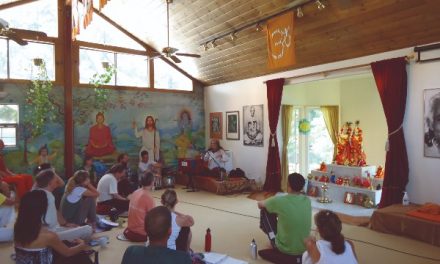 The Third Dimension
The Third Dimension
An Address to the Sivananda Yoga Teachers’ Training Course, Ustka, Poland, October 2018
by Swami Durgananda
Swami Sivananda says that yoga practitioners are mostly aware of two dimensions.

Swami Sivananda says that yoga practitioners are mostly aware of two dimensions. The first dimension is the outer life. As soon as we are born our parents take care of our outer life. They help us also to connect to the outer life. This includes education: which school I am going to, which teacher can I trust, can I make it to university or not. This is called secular, outer or worldly life. In this outer life we interact with people, some of them are friends, others are enemies. Secular life surrounds us from all sides.
This outer life values the ego and deals mostly with profit and loss: how rich do I become, how successful, how much do people recognise me, what titles do I have, how do I dress, in which part of town do I live. People and events push us towards this outer dimension, forcing us to act in the way this outer dimension expects us to act. It is very tiring and occupies most of our energy.
You may wonder whether there is more to life than this outer dimension.
You may wonder whether there is more to life than this outer dimension. This is when you enter the second di- mension, the spiritual life. Spiritual life is not an easy dimension because nowadays you have a lot of choice. In earlier times there was no choice. You were born into a religious or into a non-religious family. Traditionally in India the family would have a guru and the children would go to the same guru. Today with the help of the media we do not necessarily believe in what our ances- tors believed. This has brought about a big change in the society.
Yoga is one amongst many religious or spiritual belief systems. It believes in the existence of the atman, the Soul, the Eternal. If we engage in spiritual life through yoga we are very busy. In a way we apply the same in- tention as in secular life, we try to achieve something. The focus is on asanas, pranayama, awakening of the kundalini. We try to do everything right on the spiritual
path, just as we try to do everything right in the secular life. In this way the spiritual dimension is just as intense as the secular dimension. Swami Sivananda points out that merely focussing on the secular and spiritual dimen- sions will not really lead us anywhere.
There is a third dimension which Swami Sivananda really wants us to look at. This is the inner life.
There is a third dimension which Swami Sivananda re- ally wants us to look at. This is the inner life. It is the life of thoughts, of feelings, of attitudes, of reactions and of countless memories. This dimension lies between the secular life and the spiritual life. It is from this dimension that you decide how your outer life should be, and you also decide what spiritual life you live, or whether you become an atheist, which in itself is a spiritual choice as well. It is your conclusion about how you want to relate to God.
In order to understand Yoga, we need to focus on how it relates to this third dimension. It starts with the yamas and niyamas. The yamas are abstinence from in- jury and killing, truthfulness, abstinence from theft, con- tinence, and abstinence from greed. The niyamas consist of cleanliness, contentment, austerity, study of the self and self-surrender to God.
The yamas and niyamas purify the third dimension, the inner psychological life of our attitudes. They bring clarity into what is positive or negative, justified or unjustified, wise or unwise. This clearing up of the third dimension consists mostly of the purification of preconceived ideas. It is a psychological level of life which is extremely subtle and invisible.
As you think, so you become.
As you think, so you become—there is much truth in this sentence. If we continue to keep thinking the same way as we have in our secular life, picking up our ideas from our surroundings and the media, if we do not change our thoughts, our spiritual life will not develop either, and the third dimension will remain completely untouched.
Faith is an important aspect of the third dimension.
Faith is an important aspect of the third dimension. But blind faith is not what is meant here. When Swami Vishnudevananda would speak about faith, he would say: faith grows if you practise. When you feel the result of your practice, then faith grows. But if people do not practise at all, they have no way of developing faith. A lazy or tamasic person has no faith. A passionate or rajasic person may have faith in his or her own ego or in “give and take”.
In a pure or sattvic person the faith in the third dimension develops, and the result will show: As you think, so you become. There is nobody who can do this for you, you are the driver of your own system. Thus, the mind alone is the cause of all bondage and of course it can also be the cause of liberation. And that is the decision which is made in the third dimension. It is also called interim or in-between, as it stands between the secular and spiritual life.
It is easier to do asanas and pranayama. You may say that this is also difficult because it requires discipline. But once the discipline is in place, asanas and pranayama are easy to do. Whereas this inner life, these inner attitudes are constantly subject to greed, lack of faith, competitive attitudes, worry about tomorrow and fear of ageing. All these are influences from the outer world. They have ac- tually nothing to do with us. Our inner Self is free from this.
You can experience this when you meditate. When you have a moment of peace inside, where are all these out- er influences? Nowhere! As soon as we shut the door behind us in our home, we are with our minds. And if the third dimension is not tackled properly we become restless. Just practising asanas and pranayama cannot solve this situation. Positive thinking and meditation are required.
Helping people to bring awareness into their third di- mension—this is an important task for yoga places and organisations. Swami Vishnudevananda would tell the graduates of the Yoga Teachers’ Training Course:
“Be like light in the darkness.”
“Be like light in the darkness. You can help many peo- ple.” Personally I have seen how many of these grad- uates continued to evolve and grow and learnt how to live well on this planet. This is the intention of the Yoga Teachers’ Training Course. The goal of a yoga teacher is not to make money. You have to collect some money to pay for your hall, your food and personal expenses. But your main intention should be to serve. This is how the third dimension is purified. You are not doing this for profit, not for the ego. This is the intention for this course.
In this course you are not becoming tired from the activities themselves. You are getting tired because you are facing that third dimension, that which is deeper inside of you and which is being expanded during this course. Yoga is not what you see. You cannot see the inner di- mension. In many approaches to yoga today the inner dimension is not considered.
It is just secular life and spiritual life – you go for it and you expect things. And if that doesn’t work, you go to the next teacher, you do the next thing. This in itself is a great obstacle. Therefore, the great sages and seers taught methods of how to pay attention to what your thoughts are. It is to be practised not only when you meditate, but throughout the day also. When you sit in the evening and look back at how you reacted during the day, you can see again and again how you put the attitudes of your secular life into your spiritual life.
There is really nothing new in yoga. It could become very boring as long as you deal with yoga only in the first two dimensions. But if you enter purposefully into the third dimension, with awareness, then discrimination, viveka, will slowly awaken within you, and a whole new inner world opens up.
Be ready.
Be ready. Then you really need asanas and pranayama, because you will have surprises. You may feel ashamed that you actually think in certain ways and never knew it. Now you decide what is favourable for you and what is unfavourable for you. Something is not simply good because somebody was living like this for centuries. You have to look at it. You have to look at how you move, what you eat, how you sleep, how you interact with ev- erybody. You really look at life. You do this with your inner dimension, as well as with the help of the scriptures. It can be the Bible or any other spiritual book which speaks about the third dimension. The mind needs this mental food every day because it has a tendency to forget, be- cause it floats back into the old habits. Have you no- ticed? Even after so many years I recognise this in myself.
One aspect of laziness or tamas, consists in not entering into the third dimension. You continue to do what you al- ways did. Even though you may be quite active, it is still tamasic. Because you don’t change. This is the problem for many people. They all go in the round about. During younger years they experiment with this hair cut or that clothing fashion. But when they are forty, they become like their parents. There is no connection to the third dimension.
The most important thing in yoga is a positive attitude, a positive vision, a positive approach and a positive orientation. These are the words of Swami Sivananda: attitude, vision, approach and orientation. Then things change. The secular life starts changing, the spiritual life starts changing, you enter a different plat- form. Swami Sivananda says as long as you are in your body, the old habits will try to pull you. Therefore every day has to be a new awakening. This is also true for med- itation. You may have a good meditation today, but this does not continue forever. The next day you may be un- successful in meditation, you may fall asleep, there may be indigestion, you may hear everything around you, your body may itch or you cannot sit still. All this doesn’t matter, you sit anyway. Don’t expect anything. Do not have a pessimistic, negative attitude—what does it do for me, me, me … Remember faith. Remember to accept things as they are. And continue to work from there.
Make use of your inner faculties.
Make use of your inner faculties. Do not simply do things for which you were trained, for which you have a degree or what mother, father or friends taught you. There are many more faculties within you which you can develop. When you try to do things which you don’t know how to do, you may make a fool of yourself. Because you are never the best when you do things you have not done before. But you can learn. This also applies to yoga. Some people say: I am not really ready for yoga, I will start when I am retired. But when you are sixty, you will have many new problems which prevent you from practising. Start now, change now. Those who do volunteer service in this organisation continuously have to do things which they never did before. That is why sometimes things in the Centres and Ashrams are not perfect.
You have more talents than you think.
Use your inner faculties. You have more talents than you think. You cannot even imagine which talents are hiding within you. Slowly nourish your third dimension. Other- wise it remains asleep. You will continue to do what you always did, and you also do your asanas in the same way. Where is then the third dimension?
Everything in this world has positive and negative as- pects, every coin has two sides. This should be accepted; it is like that. You know that things are changing, you should accept the changes. Nothing is permanent, every- thing changes.
In today’s fast world there are major changes every three to four years. When you are young, you can live with this, but people who are above fifty years old, they have a hard time to keep up. Your parents know how to use a mobile phone, but maybe not everybody knows how to use a computer. Keep your mind open, keep that third dimension open, then you will be able to keep up with changes, even when you are fifty or sixty years old. When you try to be open to changes, life is not boring. And when you had a terrible day, you can start afresh the next morning.
Depending on your own psychological tendency, your connection with the third dimension corresponds to a different yoga path. In bhakti yoga we say, God put me in this situation for me to learn, it has a purpose. In jnana yoga you analyse: What is this? Why is this? Can I change it? etc., and then you come to a conclusion. In raja yoga you understand the function of the thought waves or vrittis. You look at the vrittis and you change them.
The common point in all these different paths is to change your ego and bring light into this stagnant ego attitude. We stagnate because we think we are right, the ego thinks it is right. But what is right? It is so rela- tive and depends on different circumstances. Intelligent thinking, which is guided by the scriptures, helps you to truly discriminate, so you can decide your next move, step by step.
Swami Sivananda says that until we reach Self-realisa- tion, every human being remains an individual, a psycho- logical being. In other words, we remain different until we have merged into that Self, until we allow ourselves to say: Yes, I Am. Not I am so and so, I am that, I am this—this is the psychological state.
“I Am That I Am.”
Saying “I Am That I Am” means entering into complete peace, because we now no longer differentiate.
If we are considering this, then we are really in training, and both our secular life and our spiritual life will be il- lumined by this third dimension. We gain emancipation.
Swami Durgananda is Yoga Acharya (spiritual director) of the Sivananda Yoga Centres in Europe. e-mail: [email protected]































